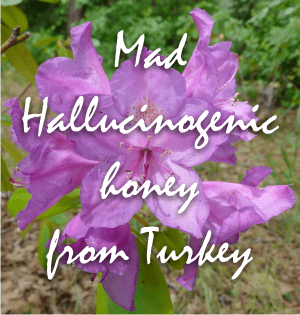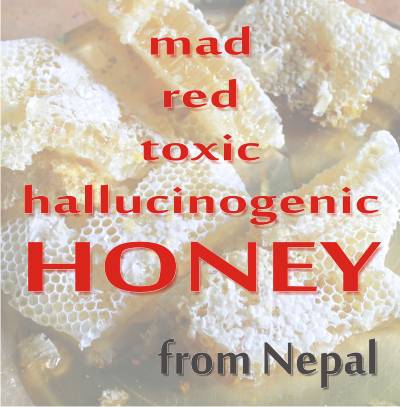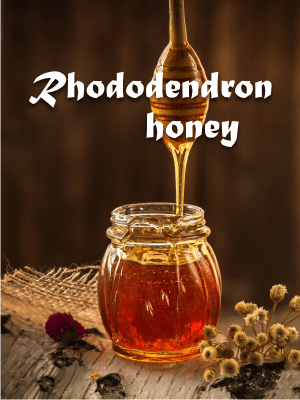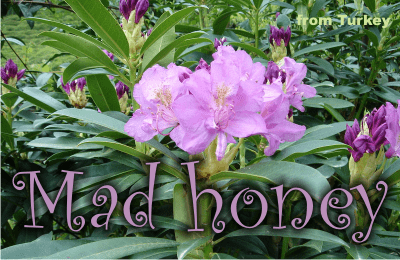Mad honey is gooood honey…. It’s honey that drives you mad, some people say.
In reality, it’s a toxic honey that has light hallucinogenic effects. Interested?
It is made from the nectar bees gather from some species of rhododendron.
However, not all rhododendron honey is toxic, as not all rhododendrons contain toxic compounds. Yet, all species produce a very-attractive-to-bees nectar.
And ultimately, we may also have a good, delicious, healthy and non-toxic honey. But here we’ll talk about the toxic one.
It was recognized that honey resulting from certain rhododendron species has a slightly hallucinogenic and laxative effect. It belongs to the category of toxic honeys, not recommended for consumption.
Grayanotoxin intoxication
The toxin responsible for the “madness” of honey is grayanotoxin, also known as andromedotoxin, acetylandromedol, and rhodotoxin. For those of you that understand this, “grayanotoxins are diterpenes; polyhydroxylated cyclic hydrocarbons that do not contain nitrogen.”
This toxin acts as a natural defence for the plant and protect Rhododendron plants from herbivore attack (as shown by Scott-Brown et al., 2016).
What is Honey Intoxication?
That’s the name of the disease you get after eating mad honey. The good news is that the intoxication is rarely fatal and generally lasts for no more than 24 hours.
Symptoms of honey poisoning
The symptoms of poisoning occur after a dose-dependent latent period of a few minutes to two or more hours and include:
- salivation,
- vomiting,
- around (or near the mouth) and extremity paresthesia (abnormal sensations).
- Pronounced low blood pressure and sinus bradycardia develop.
- loss of coordination and progressive muscular weakness – in severe intoxications
- Extrasystoles (a premature contraction of the heart that is independent of the normal rhythm and arises in response to an impulse in some part of the heart other than the sinoatrial node; also called premature beat) and ventricular tachycardia (an abnormally rapid ventricular rhythm with aberrant ventricular excitation, usually in excess of 150 per minute) with both atrioventricular and intraventricular conduction disturbances also may occur.
- Convulsions are reported occasionally.
Case reports of honey poisoning
The classical medical literature has a number of reports of toxic honey in North America and Europe. However, all
cases of mad honey poisoning in the modern medical literature are from the ingestion of honey produced in Turkey.
There are rare anecdotal reports of mild to moderate illness, which possibly represent grayanotoxin/mad honey poisoning in current North American beekeeping.
Mad honey poisoning is frequently reported in the Eastern Black Sea region of Turkey. Similar cases were reported in visitors to eastern Nepal who ate local honey derived from other rhododendron species (probably R.arboreum or R.campanulatum).
Toxic dose:
The amount of honey needed to produce toxicity is rather small. The average amount of ingested honey in one report was 13.45 ± 5.39 (5–30 g). Symptoms began one-half to three hours after ingesting the honey. Several sources report that the honey has an unusually sharp, biting taste.
Mad honey intoxication treatment:
Immediately after the intoxication, treatment with saline infusion and atropine alone is almost always successful. In a study, normal saline infusion and intravenous atropine resulted in no fatalities in 66 cases of mad honey intoxication.
In untreated cases of severe intoxication, the worst signs and symptoms lasted for about 24 hours. Complete recovery may take several more days.
Here is a “Clinical review of grayanotoxin/mad honey poisoning past and present“, by Mad Honey Poisoning Past and Present ABDULKADIR GUNDUZ1 et al. from Turkey, that I highly recommend if you want to know more.
How to prevent poisoning by mad honey
1. Boil it. In the past when the inhabitants of Pontus wanted to consume large amounts of mad honey (instead of regular honey), they used to boil the honey, either alone 5,16,42 or mixed with hazelnuts, branches of fig trees, onion, sour apples, quinces, or milk. (ERGUN K et al. 2005; BODENHEIMER, 1942; YAVUZ H, 1991)
2. Don’t eat it fresh. Storing the mad honey for long periods from 6−12 months up to several (3−5) years, was another traditional method known to diminish the risk of poisoning. (ΜΕΛΑΝΟΦΡΥΔΗΣ Π, 1951)
3. Combined consumption of mad honey from Turkey with onions was believed to be protective against poisoning.
And again, don’t do it. Don’t eat it.
Here is a story reported by David Leach on an incidence of rhododendron poisoning at Inverewe Gardens in Scotland:
“ Mr. Robert Hebb, Director of Horticulture of the Cary Arboretum, Millbrook, New York, was leading a group of American gardeners through the rhododendron collection at Inverewe Gardens in Scotland. When he stopped to photograph the salmon-pink flowers of ‘Lady Chamberlain.’, he jostled a branch and two drops of nectar fell on his finger.
Preoccupied with his photography, he unthinkingly removed the sticky nectar by putting his finger in his mouth. Hebb knew almost immediately that he had created a serious problem.
Within one or two minutes, the pleasantly sweet nectar produced a “pins and needles” tingling sensation in his fingers and toes, accompanied by numbness and lack of control in his limbs, such as when they “fall asleep.”
Within five minutes, his coordination was so impaired that he had great difficulty walking to a nearby bench. He felt weighed down by an overwhelming depression. He had a suffocating foreboding of death. He was unable to speak intelligibly, but felt the need to hide his condition from his companions.
The acute symptoms lasted 20 to 25 minutes. He then returned to the group, walking with difficulty. Speaking slowly, he was able to explain his pale and shaken appearance.
In another twenty minutes he became extremely thirsty and hungry. His mind cleared. In an hour and forty minutes after the incident, he became drowsy and a headache intensified. After sleeping for an hour, he awakened without symptoms of any kind.
Many of these are the classic symptoms of grayanotoxin poisoning. It produces a narcotic action on the brain, difficult breathing, paralysis, convulsions, and ultimately respiratory failure. As little as 28 milligrams kills a rabbit in a few hours. Mr. Hebb was lucky to recover without medical intervention.
Not everyone is as fortunate.” (“That’s Why The Lady is a Tramp” by David G. Leach in the Journal of the American Rhododendron Society, October 1982, pp 151-2)
The rhododendron honey that we find in our supermarkets is not toxic!
For 4 reasons:
1. Commercial honey packers receive honey from thousands of hives; therefore, the toxin coming from any one hive is a lot diluted.
2. To prolong life shelf of “beautiful honey”, to retard its crystallization, and kill yeast spores, honey is heated and processed. Since grayanotoxin may be heat-labile, commercial processing of honey with heat may destroy grayanotoxin in honey. Yet, the amount of heat needed to destroy grayanotoxin is not known with certainty.
3. There are means of detecting and isolating grayanotoxin from rhododendron honey, very well known by the big producers that sell it (from Italy, France or Spain).
4. Mad honey is toxic only if it is very fresh.
Toxic species of rhododendron include:
 • Rhododendron ponticum, called common rhododendron or pontic rhododendron, is a species of Rhododendron native to southern Europe and southwest Asia, but found mostly on the mountains of the eastern Black Sea area of Turkey. In this country, this honey is known as mad honey and it is harvested for medicinal purposes. Larger qualities may lead to serious poisonings, though controlled qualities can only induce hallucinogenic reactions.
• Rhododendron ponticum, called common rhododendron or pontic rhododendron, is a species of Rhododendron native to southern Europe and southwest Asia, but found mostly on the mountains of the eastern Black Sea area of Turkey. In this country, this honey is known as mad honey and it is harvested for medicinal purposes. Larger qualities may lead to serious poisonings, though controlled qualities can only induce hallucinogenic reactions.
More on this in the article Mad honey – Are you high?
Some Turkish beekeepers purposely harvest mad honey for use as an alternate health product. In Turkey mad honey used in small quantities
is widely believed to promote general health, is used as a pain reliever, is used for treatment of abdominal pain and dyspepsia, and is felt to be a sexual stimulant.
R. ponticum has been associated with honey poisoning since 401 BC.
• R. luteum – or flavum (formerly known as Azalea pontica), found in northern Asia Minor but also in Britain. This is the plant whose flowers are said to poison the honey obtained from them, as bees are very attracted to them. H. J. Ross stated in the Gardeners’ Chronicle that the poisonous principle is got rid of by heating the honey.
• R. cinnabarinum (native to eastern Nepal, Bhutan, Sikkim, southeastern Tibet, and southwest China, where it grows at altitudes of 1900–4000 meters.) and R. afghanicum ( Endemic in Kurram and the adjoining areas in Afghanistan from 2000 to 3000 m.) Its the leaves are known to have poisoned goats and sheep.
• R. occidentale‘s root contains a powerful narcotic, and according to Jepson (Fl. W. Middle Calif. ed. 2, 311) the plant is feared by sheep-men as poisonous. It is also known as “western azalea” and can be found from Oregon to southern California.
• R. macrophyllum found from British Columbia to central California.
• R. albiflorum found from British Columbia to Oregon and in Colorado.
In the eastern half of the United States grayanotoxin-contaminated honey may be derived from other members of the botanical family Ericaceae, to which rhododendrons belong. Mountain laurel (Kalmia latifolia – also from Ericaceae family) and sheep laurel (Kalmia angustifolia) are probably the most important sources of the toxin. And also from the Ericaceae family, Andromeda spp and Agauria spp.
Read more on Toxic Honeys
Health benefits of mad honey from Turkey
Why don’t all toxic rhododendrons produce mad honey?
In other words, why is there mad honey only made in Turkey or Nepal, when there are toxic rhododendrons in other parts of the world as well?
1. The density of toxic rhododendron is high enough to produce mad honey only in Turkey and Nepal. There are 6 species of rhododendron present in the flora of Turkey and the most commonly found are exactly the toxic species: Rhododendron luteum L. and R. ponticum L.
2. Some Turkish beekeepers make mad honey on purpose. They use it in small quantities to promote general health, as a pain reliever, for the treatment of abdominal pain and dyspepsia, and as a sexual stimulant.
But since the amount of grayanotoxin in mad honey is variable and uncontrollable, accidental poisoning from intentional ingestion may occur.
3. Invasive plants are not as toxic as the native ones.
It is known that rhododendron is invasive in the British Isles. A research team carried out a landscape scale chemical analysis of populations of Rhododendron ponticum in Ireland and compared this to the nectar toxin levels in its range in Spain and Portugal where the species is also native.
The results were surprising: in 1 out of 5 invasive plants, the toxins were absent from nectar. (This means that invasive toxic rhododendrons are 5 times less toxic than the native ones!) Other chemicals in the nectar, which were not toxic to bees, changed very little between the invasive and native ranges.
The explanations for this are connected to the types of bees that can tolerate the toxins (it seems that only the bumblebees (Bombus terrestris) can do that. And the Turkish Apil mellifera sub-species.)
But in order to ensure resilience and stability in our ecosystems, rhododendrons decreased the level of grayanotoxin in its nectar to make room for other pollinators to visit. (“Hidden poisons in rhododendron nectar” by Phil Stevenson & Alison Scott-Brown)
Yet, according to Kebler LF, history tells us that honey bees of Europe and North America were capable of producing mad honey, meaning that there is no difference between Turkish honey bees and honey bees in the rest of the world.
Beware of unwanted honey poisoning!
Not that somebody would ever want to get poisoned, but people who decide to eat it for its hallucinogenic effects, already know about the possible intoxication. There are warnings on the label of the jars and online ones coming from people who have already tried it and reviewed it afterwards.
Today there is increased travel throughout the world and lots of online shops which allow you to buy honey and stuff from the hardest places to reach. Thus the risk of grayanotoxin poisoning is possible outside the areas of Ericaceae-dominated vegetation, namely, Turkey, Japan, Brazil, United States, Nepal, and British Columbia.
Other cases of intoxication may result simply from unwanted contamination of polyfloral honeys with rhododendron nectar. With our modern tendency to get back to “all natural”, honey is proffered in its “raw” form – as it is healthier. But the bad sides is that some spores and toxins can also get into honey – which would otherwise be killed through processing.
Perhaps gamma irradiated honey is healthier and safer. We will see what the future holds for us.
Other than that, grayanotoxin poisoning in humans is rare. 🙂
Where can I buy mad honey from?
I hear this question all the time. In our search for a way to entertain ourselves, we think we can handle the toxicity of it and be ok if we stick to the recommended dose.
What can I say, this can be true. But it is not easy to get REAL mad honey. Honey may only be contaminated with grayanotoxin and not have the necessary quantity to induce the hallucinogenic effect we desire. Or it may be too much of it.
The only way to be sure is to buy it from the Turkish or Nepalese locals, who will also tell you how to take it for good results. They know how, they have been using it as medicine since … forever. Nevertheless, it’s pretty hard to get to them.
 Do not confuse the locals with the ones selling it online. I personally do not trust them. They may simply take advantage of the huge popularity of this type of honey and sell something at very high prices. (Really, how can we know for sure what’s in there? On their word?)
Do not confuse the locals with the ones selling it online. I personally do not trust them. They may simply take advantage of the huge popularity of this type of honey and sell something at very high prices. (Really, how can we know for sure what’s in there? On their word?)
• Real mad honey can be found in Nepal. You can take trips in the mountains and see the honey hunters in action. Please read the article Himalayan Red Honey – aka mad, toxic, hallucinogenic honey from Nepal. and find out what to do for this.
• Or, try the mad honey produced in Turkey. Read this: What is Mad honey from Turkey, aka Deli Bal, and what is it good for?
********************
References and picture sources:
http://rhodyman.net/rhodyntox.php
Rhododendron ponticum By First Light at English Wikipedia, CC BY-SA 3.0, https://commons.wikimedia.org/w/index.php?curid=6644210;
Rhododendron wardii var. puralbum By KirinX at English Wikipedia – This photo was taken by Jesse Hickman (User:KirinX) with his Sony Alpha A100. You can find more Wikipedia-friendly photography by KirinX at his gallery., CC BY-SA 2.5, https://commons.wikimedia.org/w/index.php?curid=41239280 ;
Kebler LF. Poisonous honey. Am Pharm Assoc Proc 1896; 44:167–174.
ABC of Complementary medicine: Herbal medicine. One Hundred
years ego-Honey poisoning (bmj 1899; ii: 674). BMJ 1999; 319:1422.
https://www.thevespiary.org/rhodium/Rhodium/Vespiary/talk/files/5146-Clinical-review-of-grayanotoxin.mad-honey-poisoning-past-and-present.efd9.pdf



